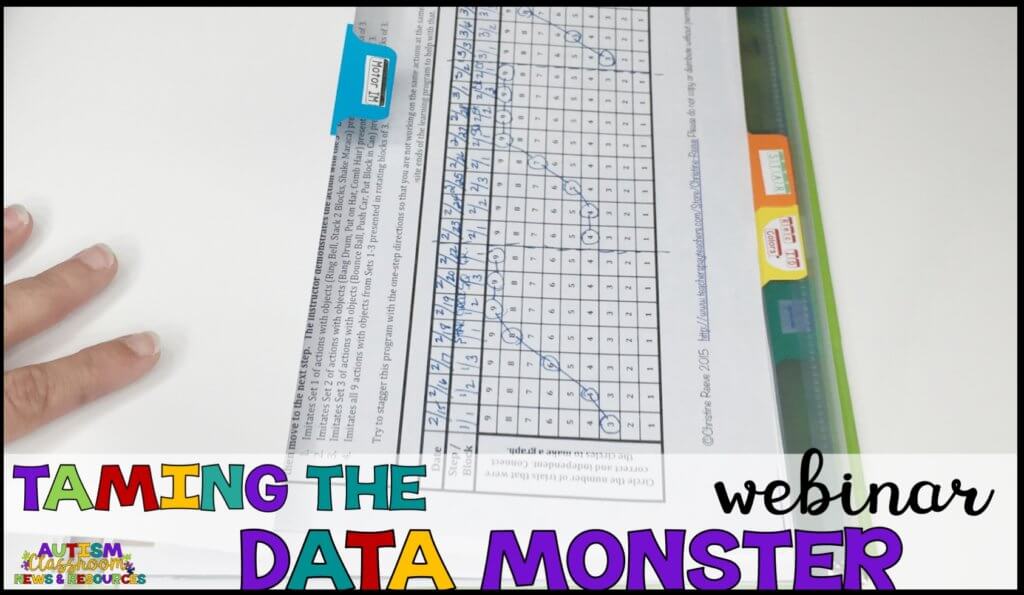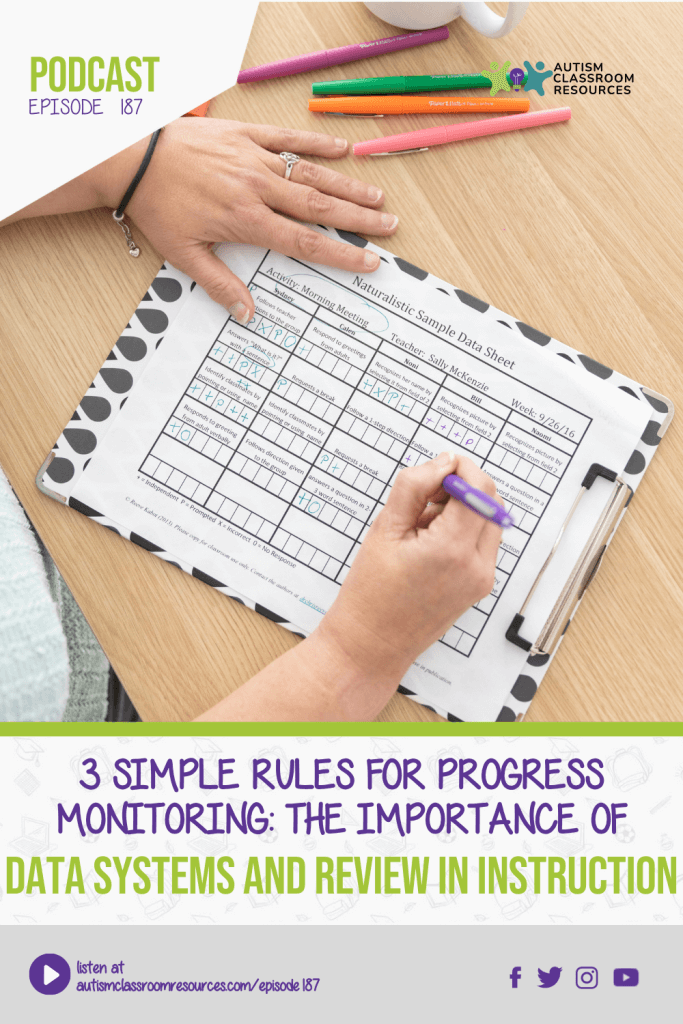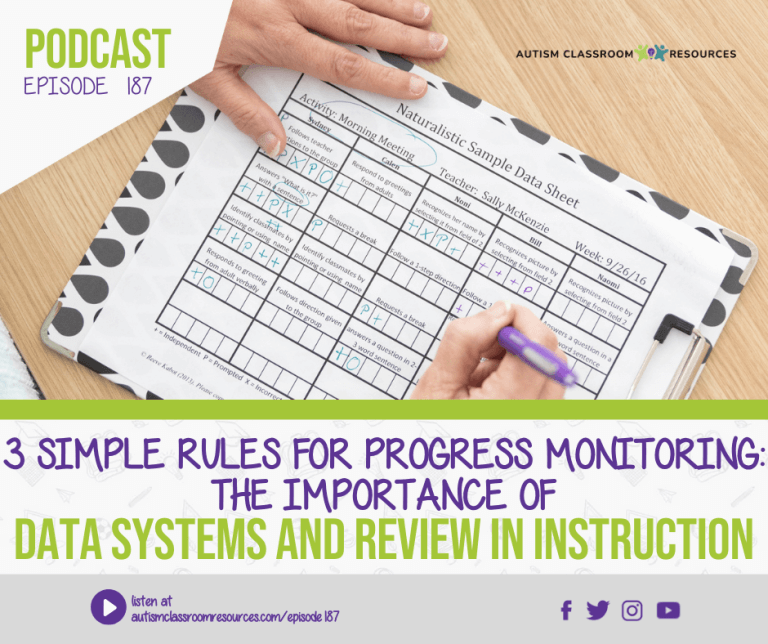Welcome to the Autism Classroom Resources Podcast, the podcast for special educators who are looking for personal and professional development.
Christine Reeve: I’m your host, Dr. Christine Reeve. For more than 20 years, I’ve worn lots of hats in special education but my real love is helping special educators like you. This podcast will give you tips and ways to implement research based practices in a practical way in your classroom, to make your job easier and more effective.
Welcome back to the Autism Classroom Resources Podcast. I’m Chris Reeve, and I’m your host. We are in the midst of a series of bite sized episodes on the elements of instruction. These are elements of instruction broken down from simple instructional loops of each opportunity to answer or respond to a direction. And you can get an overview of all of them back in episode 180.
This week is all about progress monitoring, or data, which is not a four letter word, even though it is a four letter word, and the importance of analyzing our instructional data. And I’ve got some free tools that will help you do this. So don’t panic. And let’s get started.
I am not a big fan of the statement, if there’s no data, it didn’t happen. Of course it happened. We just can’t easily demonstrate it. However, you don’t always need to. If a student is progressing through the steps of a curriculum regularly, and periodic tests tell us that they understand and have learned the information, we don’t have to take data on every little assignment that they do. Also, good teaching is more important than having data, particularly when you’re starting.
Here’s the thing, if you aren’t having the opportunity to really teach the skill well, the data you take will likely not show much progress. Over the years I’ve seen so many teachers beat themselves up about not having enough data. And they bring me boxes of data that they’ve taken with no system in place to how it was taken, when it was taken, or anything like that. And it just ends up not being really helpful because we can’t make sense of it. And I just think about what they could have done with their students in the time that it took them to do that.
Now, I wrote a whole book on data collection in the classroom. So please don’t interpret those statements to mean that I think we shouldn’t be taking data in class. That is definitely not the case. But we need to take smarter data, not more data, we need a system.
Now I talked about how to create a system of data collection way back in episode 87. And you can listen to it at autismclassroomresources.com/episode87 We need to be smarter in how we take our data. And we also need to make sure that we’re using our data to guide our decision making. That means we need to summarize our data, analyze it, and make changes to our instruction. That is what makes it true progress monitoring. The idea behind any form of progress monitoring is that you’re using students performance to guide how you teach.
I have a free webinar that you can take on demand that will walk you through how I set up systems of data collection for instruction, progress monitoring. I share one of my data sheets as well as how we decide how much data you need and things like that in your classroom. And you can watch that and get a certificate for completion at autismclassroomresources.com/datamonster all one word.
So how do you know how much data to take? Here are a couple simple rules to use. If a student is making progress, you need less data. Think sample data or test data. And as a general aside, if you can take sample data or test data for something, do it. If you can use a work sample or give a test, do that it’s the easiest thing to do. If a student is not making progress, then we need more data. You need more frequent data. And we just basically need more data points to figure out what’s going on so we can make changes.
Another rule is that skills that have smaller steps to master that the student is going to learn those steps more quickly, those we need more data or more frequent data on, more frequent progress monitoring than those that have big steps.
And here’s an example of what I mean. If I’m teaching a preschooler how to follow simple directions and my curriculum or my teaching program says that I present one direction till they get it right three trials in a row. And then I move on to the next direction. I need data on those three trials. And that means I need to take data pretty much every time I’m teaching the skill because that can go really fast in that kind of instruction.
A sample of data won’t help me if I take it Monday, and we don’t take another until the end of the week. And if they got it on Tuesday, then they have over practice that skill, and we’re going to have to unteach it before we move on. Whereas we would have moved on much faster if we’d been taking data every day. On the other hand, if I’m teaching a skill that requires 80%, accuracy on a weekly test before we move on to the next skill in the curriculum, I just need the weekly test. I don’t need more data than that. Unless the student is struggling with the concepts and failing the test, then I might need to up the data and see what’s happening, and monitor it more closely.
And finally, the third rule that I want to talk about today is that if you don’t review your data, it really doesn’t do you any good for progress monitoring. Because you aren’t actually monitoring it. Just taking the data doesn’t help. Yes, it gives some level of documentation that you’ve implemented things. But it isn’t the reason that we take data.
You need to set up systems for analyzing your data and that also doesn’t have to take over your life. But it does take getting into some habits to make it work. And I talk all about how to set up a system for analyzing your instructional data in episode eighty eight. So autismclassroomresources.com/episode88 will get you to that so you can read or listen.
In addition, it’s helpful to analyze your data and compare it to your expected progress. Say for when they’re supposed to master the skill on the IEP, and compare whether or not their progress is meeting it.
I’ve got a free Google Sheet or an Excel spreadsheet, whichever you prefer, that you can download, that can be used for a lot of different kinds of data. But I created it for analyzing sample data that I take with my naturalistic data sheet, which I talked about in the free webinar that I mentioned earlier.
Each week, you put in your sample data of how many opportunities the student correctly completed the target skill, and how many opportunities he had to complete it. And then it graphs it for you. And you can then draw a line for the progress of where and when they’re supposed to have mastered it on the graph, when are they supposed to be at a certain percentage. And then you can just look and see if you’re climbing up that progress line on time. You don’t need to do anything if they are. Your progress monitoring in that case is telling you that what you’re doing is working. If your data falls below that line, then you might need to increase both your instruction and your data to try to figure out what the problem is.
Now, if you’re in the Special Educator Academy, we have a whole course on taming the data monster that walks you through each of these situations. In addition, we have a tool to interpret the data and decide what to do when the student isn’t making the progress that you need. It’s kind of like a cheat sheet for analyzing data. And it just so happens that October when this episode is airing, is data month in the academy. So all these resources are upfront, as well as there are editable versions of my behavior and instructional data sheets there as well.
So if you’re listening to this in October, come join us at specialeducatoracademy.com, you can actually come join us whenever you’d like. The data course will always be there. We just happen to be focusing on data collection this month. And if you want to get the data sheets as part of your membership, sign up at the top of the page where it says, want to skip the trial? The free products don’t kick in until the trial is over. So I don’t want you to miss those. But you will have access to the data course no matter when you join, and the data resources and more.
And if the academy isn’t for you, I’ll link to the data sheets in the show notes in my store, as well as the two free tutorials in Excel and Google sheets that you can analyze your data for free. And I’ll also make sure that there’s a link to the free data webinar as well.
So your action plan or action activity for this episode is to look at your data collection and see if you are consistently analyzing your data that’s collected or if that’s something that you feel you might want to tweak a little bit to make it less overwhelming.
Thanks so much for tuning into this episode. Next week, I will be back to talk all about learning readiness skills and what that even means. If you found this episode helpful, I would love it if you would share it with a friend or colleague or hop over to Apple podcasts and leave a review of the podcast itself. I always love to hear from listeners with their thoughts about episodes as well. So feel free to DM me on Instagram or tag me with this episode if you’re listening to it and it’s working for you. And you can always find me on Instagram @autismclassroomresources. Have an amazing week and I hope to see you back next week.
Thanks so much for listening to today’s episode of the Autism Classroom Resources podcast. For even more support, you can access free materials, webinars and Video Tips inside my free resource library. Sign up at autismclassroomresources.com/free. That’s F-R-E-E or click the link in the show notes to join the free library today. I’ll catch you again next week.







